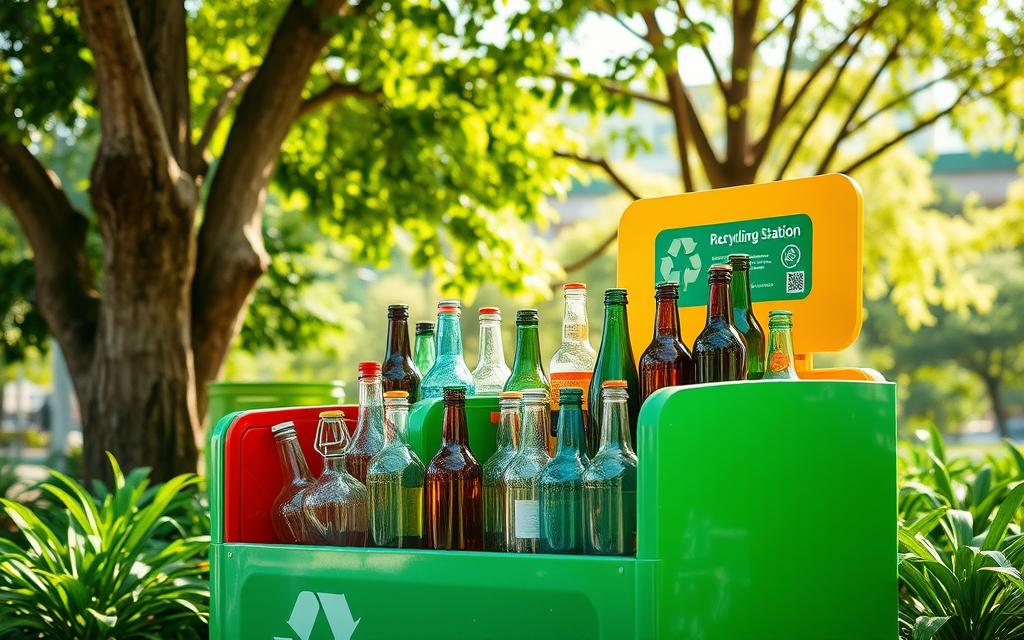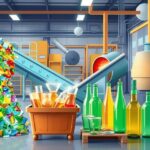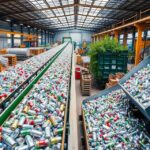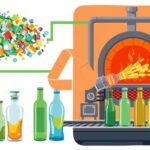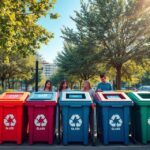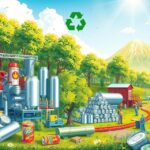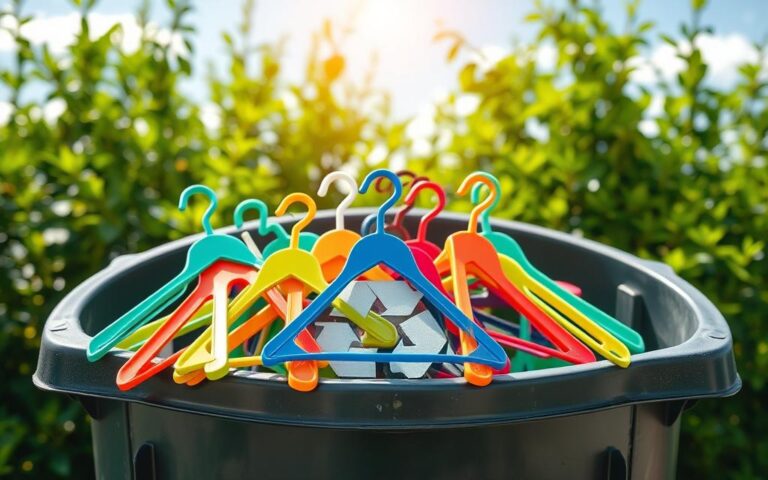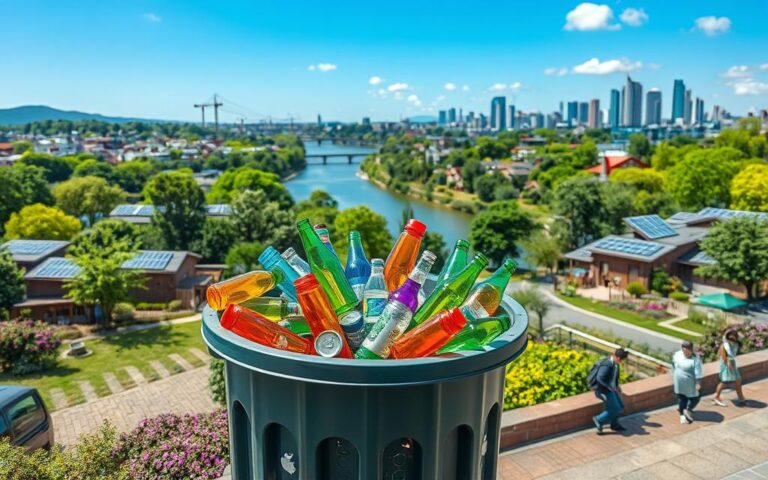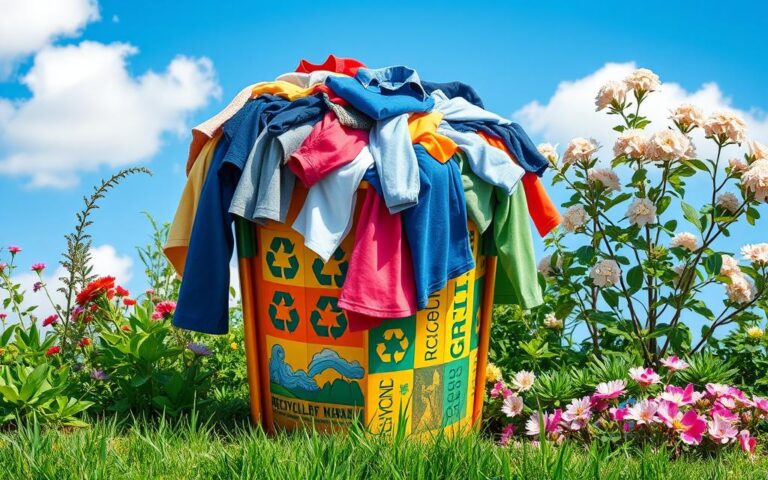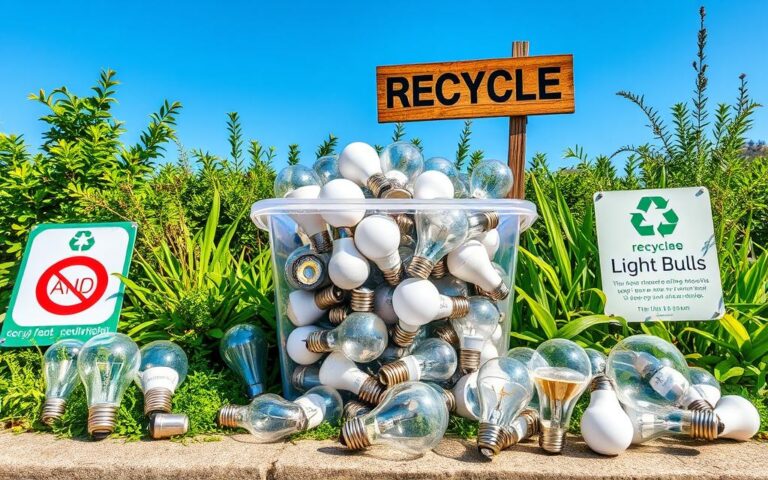Does Glass Go in the Recycling? Key Facts
Glass recycling is key to keeping our planet healthy. It lets us use glass over and over without losing its quality. But, in the UK, only a little over 31% of glass from foods and drinks was recycled in 2018. This shows we need to learn how to recycle glass better.
Recycling glass saves a lot of natural resources. For every ton recycled, we save 1,300 pounds of sand, 410 pounds of soda ash, and 380 pounds of limestone. Check out the environmental benefits online. Using more recycled glass cuts energy costs and greenhouse gases. In fact, recycling one ton of glass stops one ton of carbon dioxide from going into our air.
Knowing these recycling facts should drive us to recycle more glass. If we all do our bit, we can make a big difference. Recycled glass helps us save our planet and our resources.
Understanding Glass Recycling
Glass recycling is key to keeping our planet healthy. It helps us save energy and reduce waste. By knowing which glass items can be recycled, we can make a big difference. This process is important for protecting our environment.
What Types of Glass Can Be Recycled?
Much of the glass we use every day can be recycled. This includes bottles and jars used for food and drinks. However, glass from windows, ovenware, Pyrex, and crystal cannot be recycled. It’s crucial to separate them correctly to make recycling work well.
| Type of Glass | Recyclable |
|---|---|
| Food and Beverage Containers | Yes |
| Windows | No |
| Ovenware | No |
| Pyrex | No |
| Crystal | No |
The Process of Glass Recycling
The first step in recycling glass is collecting it. Next, it gets sorted so only the right kinds are recycled. The glass is cleaned, crushed, and then melted to make new items. Glass can be recycled over and over without losing its quality.
Using recycled glass saves up to 95% of the raw materials needed for new products. It also helps factories lower their pollution and save equipment. Recycling glass is good for both the environment and businesses.
Environmental Impact of Glass Recycling
Recycling glass has a big impact on our planet. It helps save energy and reduces costs for companies making glass containers. For every six tons of glass recycled, we can prevent about one ton of CO2 emissions. This makes the air and water cleaner, showing how important recycling is.
Does Glass Go in the Recycling?
Glass containers are key in recycling, making up a large part of recyclable materials. Knowing about them helps us recycle glass effectively.
Facts About Glass Containers
Glass packaging comes in several types, like clear, green, and amber. These are common in jars and bottles. Now, the average bottle is made of 52% recycled content. This shows how the industry values sustainability.
Retailers react to the public’s call for sustainable products by choosing glass that can be recycled over and over. This move meets market demands and cuts down on environmental harm.
However, not all glass items, like nail varnish bottles, light bulbs, and cookware, can be recycled at home. To boost glass recycling, one can ask local leaders for more recycling sites. Such actions could raise glass recycling rates in our areas.

Glass Recycling Rates in the UK
The UK keeps up excellent glass recycling numbers. Recently, data showed about 80.1% of glass is recycled in Europe. In the UK, 80% of homes recycle their glass, marking a big leap forward.
High recycling rates show people are acting responsibly. It helps the country reach its sustainability goals. Using recycled glass in new products is fast, taking about 30 days. This quick turnaround highlights the importance of recycling glass the right way.
Knowing more about glass recycling can help us improve the UK’s recycling figures. This will do good for the planet.
The Benefits of Recycling Glass
Recycling glass has many advantages for our planet and economy. It leads to energy savings, reduces CO2, and saves resources. Understanding these benefits shows why it’s important to recycle glass carefully.
Energy Savings from Recycling Glass
Recycling glass saves a lot of energy. Cullet, or crushed recycled glass, needs less heat to melt than new materials. This means making glass uses less energy. Using more cullet can reduce energy use by up to 3% for every 10% increase in cullet.
Reduction of CO2 Emissions
Recycling glass greatly reduces CO2 emissions. Making glass from cullet cuts down air and water pollution by 20% and 50%, respectively. Recycling six tons of glass can cut CO2 emissions by one ton. This helps fight climate change and protects the environment.
Resource Conservation: What’s Saved?
Recycling glass helps save a lot of natural resources. It means less mining because glass can be melted and reused. This makes things like new bottles or glass fibre. By recycling, we use less landfill. This supports making products in a more eco-friendly way.
| Benefit | Impact |
|---|---|
| Energy Savings | 3% reduction in energy consumption per 10% increase in cullet use |
| CO2 Reduction | 1 ton of CO2 emissions avoided for every 6 tons of glass recycled |
| Resource Conservation | Conserves significant natural resources; less demand for mining |
| Landfill Space | Reduces landfill space occupied by glass bottles and jars |
Common Misconceptions About Glass Recycling
Many people think all glass items can be recycled. This isn’t true. Materials like cookware and window glass aren’t recyclable like bottles. They have different compositions and need separate disposal. Understanding this is key to improve recycling.
Is All Glass Recyclable?
Not all glass is recyclable, and it’s important to know this. Recognising the difference aids in proper disposal. This knowledge is vital for boosting recycling efforts and minimizing landfill waste.
Can You Recycle Glass with Labels?
There’s also confusion about glass labels. Some think they need removing before recycling. But labels can stay on; they are removed later. Clearing up these myths encourages better recycling practices. It helps the environment and supports the economy.
FAQ
What types of glass can be recycled?
You can recycle most food and beverage containers if they’re made from clear, brown, or green glass. But, cookware and window glass usually aren’t accepted. Their materials are different from regular recycling programs.
What is the process of glass recycling?
First, we collect and sort the glass. Then, it’s cleaned and crushed into small pieces, called cullet. The cullet is melted and shaped into new glass items. This means glass can be endlessly recycled without losing its quality.
What is the environmental impact of recycling glass?
Recycling glass helps our planet a lot. It saves natural resources, uses less energy, and cuts down on greenhouse gases. For example, recycling a ton of glass cuts carbon dioxide emissions by a ton. It also saves loads of raw materials.
What are the facts about glass containers in recycling?
In the UK, we recycle a lot of glass containers. About 64% are clear, 23% are brown, and 13% are green. Thanks to good recycling programs, more glass is getting recycled now than before.
What are the current glass recycling rates in the UK?
In 2018, the UK recycled about 31% of glass food and beverage containers. These days, about 80% of homes recycle their glass. This shows how more people are getting into recycling.
What are the benefits of recycling glass?
Recycling glass is great for saving energy. For example, a recycled bottle can power a light bulb for four hours. It greatly reduces CO2 emissions, too. Plus, it saves important natural resources.
How does recycling glass contribute to resource conservation?
By recycling glass, we save a lot of resources. We can save 1,300 pounds of sand, 410 pounds of soda ash, and 380 pounds of limestone for each ton of glass recycled. This reduces the need to mine these resources from nature.
Is all glass recyclable?
Not all glass can be recycled. Food and beverage containers are mostly okay, but things like cookware or window glass can’t be recycled the usual way. They’re made differently.
Can you recycle glass with labels?
Yes, you can leave labels on glass items for recycling. They are taken off in the recycling process. It’s good to know this to help improve recycling.

